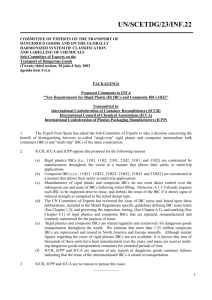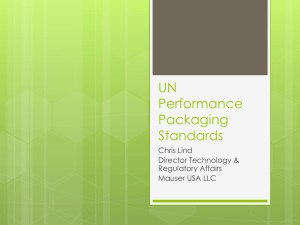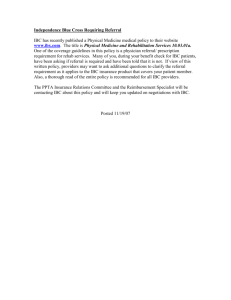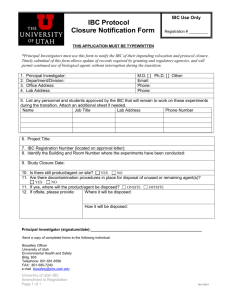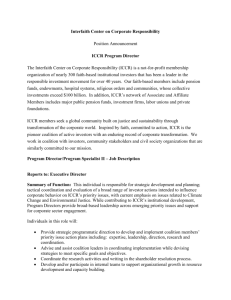un/scetdg/33/inf.60
advertisement
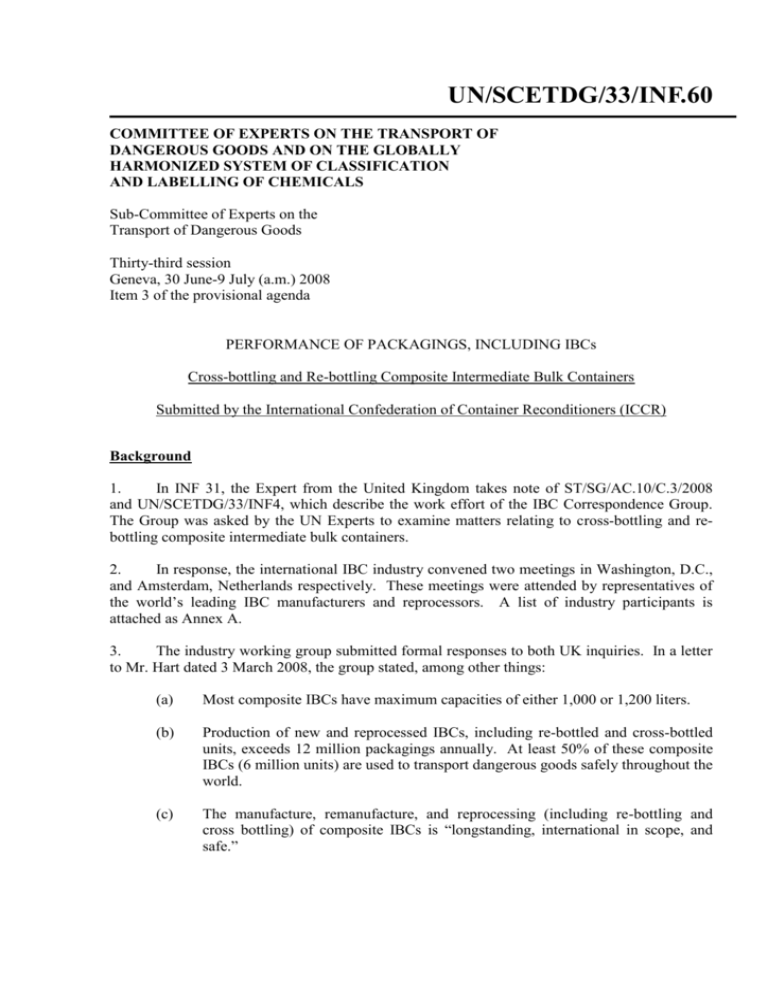
UN/SCETDG/33/INF.60 COMMITTEE OF EXPERTS ON THE TRANSPORT OF DANGEROUS GOODS AND ON THE GLOBALLY HARMONIZED SYSTEM OF CLASSIFICATION AND LABELLING OF CHEMICALS Sub-Committee of Experts on the Transport of Dangerous Goods Thirty-third session Geneva, 30 June-9 July (a.m.) 2008 Item 3 of the provisional agenda PERFORMANCE OF PACKAGINGS, INCLUDING IBCs Cross-bottling and Re-bottling Composite Intermediate Bulk Containers Submitted by the International Confederation of Container Reconditioners (ICCR) Background 1. In INF 31, the Expert from the United Kingdom takes note of ST/SG/AC.10/C.3/2008 and UN/SCETDG/33/INF4, which describe the work effort of the IBC Correspondence Group. The Group was asked by the UN Experts to examine matters relating to cross-bottling and rebottling composite intermediate bulk containers. 2. In response, the international IBC industry convened two meetings in Washington, D.C., and Amsterdam, Netherlands respectively. These meetings were attended by representatives of the world’s leading IBC manufacturers and reprocessors. A list of industry participants is attached as Annex A. 3. The industry working group submitted formal responses to both UK inquiries. In a letter to Mr. Hart dated 3 March 2008, the group stated, among other things: (a) Most composite IBCs have maximum capacities of either 1,000 or 1,200 liters. (b) Production of new and reprocessed IBCs, including re-bottled and cross-bottled units, exceeds 12 million packagings annually. At least 50% of these composite IBCs (6 million units) are used to transport dangerous goods safely throughout the world. (c) The manufacture, remanufacture, and reprocessing (including re-bottling and cross bottling) of composite IBCs is “longstanding, international in scope, and safe.” UN/SCETDG/33/INF.60 page 2 4. In an attachment to the 3 March 2008 letter, the International Confederation of Container Reconditioners (ICCR) provided incident statistics from the United States for the years 2003 – 2006. In summary, these statistics show the following: (a) Approximately 9.2 million new and reprocessed IBCs were sold in the U.S. from 2003 – 2006. (b) From 2003 to 2006, there were 851 total reported IBC incidents, resulting in 1058 IBC failures. Of these, 281 incidents (27%) involved metal IBCs, and 241 incidents (23%) did not specify the type of IBC. The remaining 534 reports (50%) did involve, or were likely to have involved, composite IBCs. (c) The vast majority of reported incidents (61%) were caused during loading and unloading operations. Human error, forklift puncture, drops and vehicular accidents were a significant source of “container failure.” (d) There were no fatalities associated with these incidents; response costs averaged less than 260.00 (Euro) per incident, and property damage was less than 140.00 (Euro) per incident. (e) Total failures (1058) calculated as a percentage of total units sold during the fouryear period were approximately .01%, or about 1 per 10,000. Total incidents involving plastic or likely plastic units was 0.003 - 0.005%, or 3 – 5 per 100,000. 5. Based upon these statistics, ICCR concludes that both new and reprocessed IBCs are extremely safe and reliable packagings for the transport of dangerous goods. The failure rate for all IBCs is low, and the failure rate for known or likely plastic IBCs is extremely low. Importantly, a high percentage of all reported incidents involving IBCs occur not during movement in transport, but rather during loading and unloading activities. Discussion 6. INF. 31 is titled “Cross Bottling of IBCs.” Earlier documents prepared by the UK and other Experts use the term “re-bottling,” as well. ICCR believes it would be valuable to define these terms for purposes of discussion. To this end, we offer the following definitions: Re-bottled IBC means a rigid composite IBC which has had the inner receptacle replaced with an inner receptacle of the original design type. Cross-bottled IBC means a rigid composite IBC which has had the inner receptacle replaced with an inner receptacle of a different design type. 7. INF. 31 suggests replacing the term “original manufacturers’ specification” in the definition of repaired IBC with “original design type from the same manufacturer.” ICCR supports changing the term ‘specification’ to ‘design type’ but does not support including the additional words ‘from the same manufacturer.’ UN/SCETDG/33/INF.60 page 3 (a) The term “original design type” is sufficiently precise to ensure that the inner receptacle of a composite IBC conforms in relevant aspects to the inner receptacle design offered by the original manufacturer. (b) Today, most manufacturers of composite IBCs outsource the manufacture of IBC parts, e.g., pallet, valves, caps, pressure relief valves, etc. By adding the words “from the same manufacturer” the UN would effectively require IBC manufacturers to reveal the source of these parts, which are often considered trade secrets. (c) The use of the modifying phrase “from the same manufacturer” would put the UN in the position of limiting trade by regulation. Commercial issues of this kind have traditionally been left to the marketplace and the courts. ICCR is deeply concerned that if the UN requires replacement bottles to be obtained only from the “original manufacturer,” other packaging manufacturers could in the future turn to this body for help in protecting their markets. 8. ICCR understands the need for competent authorities to be certain that replacement inner receptacles of composite IBCs are safe. 6.1.5.1.8 of the Model Regulations currently provides competent authorities the authority to require proof, via tests, that IBCs meet the requirements of the applicable design type tests. ICCR, therefore, proposes to clarify this provision by specifying that competent authorities may request proof of testing from persons performing repairs. 9. INF. 31 proposes a new 6.5.2.2.4 requiring inner plastics receptacles to be marked with the markings specified in 6.5.2.1.1 (b), (c), (d), (e), and (f). The Expert from the UK justifies this proposal by stating that these marks will “ensure that each inner bottle can only be associated with the correct type of outer casing.” Current 6.5.2.2.4 requires all inner receptacles to be marked with the name or symbol of the manufacturer, date of manufacture, and the state authorizing the mark. These marks correspond to 6.5.2.1.1 (f), (d), and (e) respectively. The UK has proposed two additional marks for the inner receptacle indicating the IBC code (e.g., 31HZ1) and the packing group (e.g., “Y”). ICCR believes the two “new” markings do not associate the inner receptacle with the outer receptacle more efficiently than does current 6.5.2.2.4. Additionally, the additional marks serve no apparent safety purpose. New inner receptacles marked under the proposed new scheme, for example, would not bear the same date as those being replaced. Virtually all composite IBCs are marked to Packing Group II (i.e. “Y”). Blow-molded rigid IBC bottles are one component of a composite IBC, and are not otherwise authorized for use in the transport of dangerous goods. ICCR suggests that 6.5.2.2.4 be amended: (a) to specify the location of the marks on the inner receptacle near the filling port, thereby ensuring their visibility, and (b) to require that the marks be permanent. Clarification of these points will ensure inspectors and fillers have ready access to these marks. UN/SCETDG/33/INF.60 page 4 10. ICCR further believes that safety benefits would be derived by specifying the location of markings in 6.5.2.1.1 and 6.5.2.2.1. Currently, these two marks are not required to be placed near one another. 6.5.2.1.1 says that marks should be “…in a location so as to be readily visible.” 6.5.2.2.1 says that marks should be on a corrosion-resistant plate “permanently attached in a place readily accessible for inspection.” In fact, it is often the case that the two marks appear on opposite sides of the IBC. ICCR, therefore, proposes that the marks in 6.5.2.1.1 be amended to assure that these marks are readily visible and placed on the corrosion resistant plate near the marks in 6.5.2.2.1. 11. INF. 31 proposes to add a new paragraph to 6.5.2.4 requiring remanufacturers to remove the markings in 6.5.2.1.1 and 6.5.2.2.1 from “the original IBC.” ICCR opposes the UK language because it is vague and could require the destruction of reusable outer receptacles. The Model Regulations currently refer to the original marks required to be placed on IBCs by manufacturers as “primary” (6.5.2.1) and “additional” (6.5.2.2). The primary marks are applied in a durable manner, while the additional marks must appear on a corrosion resistant plate that is permanently attached to the IBC. The additional marks are typically embossed and appear on a plate that is welded to the IBC. In addition, the two sets of marks often appear in different locations on a composite IBC. Since the proposal in INF 31 would require IBC remanufacturers to remove these marks from an IBC, and because the additional marks (6.5.2.2.1) are often embossed on a plate permanently attached to the IBC, fulfillment of this requirement could cause the destruction of the IBC itself, as in the case of a welded plate. ICCR, therefore, proposes to amend 6.5.2.3 to require remanufacturers to “invalidate or remove” these marks. 12. INF. 31 proposes an amendment to 6.5.4.1 to clarify that remanufactured and repaired IBCs are produced in accordance with a quality assurance program. ICCR agrees with this proposal. Proposals Deleted existing language Proposed new language 13. Amend 1.2.1 Amend the definition of “repair” in 1.2.1 by deleting “original manufacturer’s specification” and replacing it with “original design type.” UN/SCETDG/33/INF.60 page 5 14. Amend 6.1.5.1.8 “The competent authority may at any time require proof, by tests in accordance with this section, that serially-produced packagings, including repaired IBCs, meet the requirements of the design type tests.” 15. Amend 6.5.2.2.4 The inner receptacle of composite IBCs shall be marked permanently with at least the following information, which shall appear in a readily visible location near the filling port. 16. Amend 6.5.2.1.1 “Each IBC manufactured and intended for use according to these Regulations shall bear markings which are durable, legible, and placed in a location so as to be readily visible and placed near the marks in 6.5.2.2.1 on the corrosion resistant plate. Letters, numerals and symbols shall be at least 12 mm high and shall show:” 17. Revise 6.5.2.3 to read: “Conformity to design type: The marking indicates that the IBCs correspond to a successfully tested design type and that the requirements referred to in the certificate have been met. In an IBC no longer meets the design type, or has been remanufactured, the original manufacturer’s marking indicating the IBC corresponds to a UN design type shall be removed or invalidated.” UN/SCETDG/33/INF.60 page 6 Appendix A List of Participants Amsterdam Meeting of the Industry IBC Working Group 14 April 2008 Name Juergen Bruder Chris Lind Dietmar Przytulla Phil Pease Carsten Dresen Mark Sengelin Peter Heijink Thilo Klein Company ICPP Mauser Mauser IPA Werit Sotralentz Schuetz Affiliation ICPP ICPP ICPP ICPP ICPP ICPP ICPP ICPP Jerry Geyer Robert Harding Greif IBCNA ICIBCA ICIBCA Jeff Bey Larry Bierlein Chris Shocklee Peter Schaeffer Brian Chesworth Frits Janus Pim Janus Calvin Lee Eddie Schuer Paul Rankin K. Nakamura I. Hiramatsu Y. Ando Bert Himpe Peter Claes Mike Rooms Recycle, Inc. ICCR Drumtech National Container ICCR Janus Vaten Janus Vaten ICS, Inc. Pack2Pack RIPA JDRA JDRA JDRA Pack2Pack Pack2Pack Ken Rooms, Ltd. ICCR ICCR ICCR ICCR ICCR ICCR ICCR ICCR ICCR ICCR ICCR ICCR ICCR ICCR ICCR ICCR ___________________

